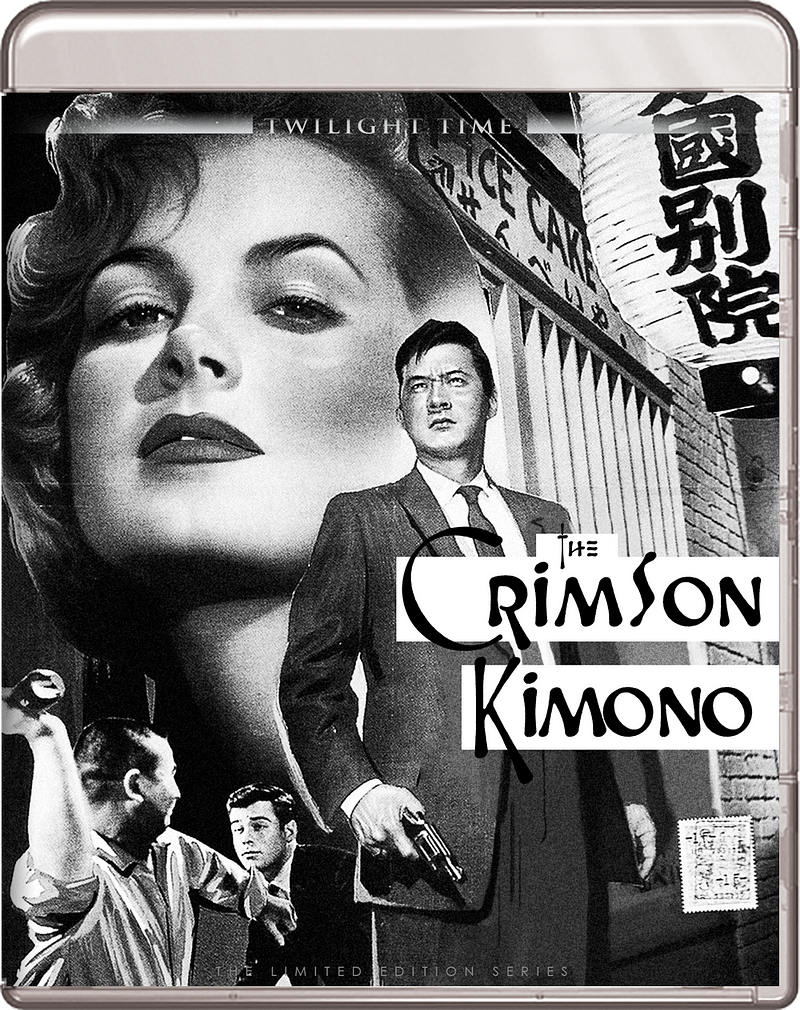
Synopsis
Maverick writer-director Samuel Fuller’s The Crimson Kimono (1959) is a noir-ish tale of two Los Angeles cops (James Shigeta, Glenn Corbett) attempting to solve the murder of a stripper in Little Tokyo. But along the way, Fuller typically introduces themes of racism and sexual identity, particularly when a young woman (Victoria Shaw), a possible key witness, enters the picture, disrupting the relationship of the two police partners.

If you dig into the promotional materials for The Crimson Kimono, you’re faced with provocative taglines such as “YES, this is a beautiful American girl in the arms of a Japanese boy!” and “WHY DOES SHE CHOOSE A JAPANESE LOVER?” It’s a misguided attempt to sell the film as more provocative fare; the reality is it’s far more nuanced. While the noir/crime thriller is what kicks off the film, it really serves as a platform to examine an interracial relationship in 1950s America. Glenn Corbett and James Shigeta play Los Angeles police detectives investigating a murder. Charlie is white, and Joe is a Japanese American. Their friendship stretched back to service during World War II, something touched upon in the film. Their work in the case causes them to cross paths with a painter called Chris (Christine, played by Victoria Shaw). While both men are captivated, Chris only has eyes for Joe.
It’s a tale that you’d think would veer into an examination of society laying judgement on such a pairing, and not just because of the aforementioned marketing ploy. Instead Sam Fuller inverts those ideas. With an expectation of societal criticism and pressure, Joe prepares himself for the backlash he expects, but when it fails to arrives, he begins crafting a problem within his own mind, one that eventually manifests itself in reality. The fallout significantly affects his relationship with partner Charlie, whose anger at being rejected by Chris is interpreted by Joe as racism. What’s already an unconventional love triangle turns into an examination of how racism can tinge the perception and judgement of even those who are typically the victims of such bigoted behavior.
The Crimson Kimono offers a rather tender portrayal of Japanese culture in the midst of this American city, on the nose insensitive musical cues aside. This juxtaposition of two cultures is one of the most intriguing facets of the film. Two cultures, not long from being at war with one another, now exist side by side, both in terms of society in general and the two leads as well. It adds plenty of potency when emotions between the pair finally erupt, most notably in a kendo sparring session. It’s one of the more impressive aspects of Fuller’s work, bringing real weight to the emotion and physical aggression. It’s a smartly composed scene that brings much of Joe’s conflict and relationship with his own culture to the fore. The scene is the most memorable one in the film, with few others that come close to its potency. Despite its interesting take on racial issues, it’s a shame that such resonance isn’t sustained throughout.

The Package
Image quality in the release is somewhat variable, at times crisp, others more grainy. Contrast and detail is good throughout; overall, it’s a great looking transfer. As ever with Twilight Time, the release includes liner notes offering commentary on the film, this time another quality piece by film historian Julie Kirgo. Special features include:
• Sam Fuller Storyteller: Running 24 minutes, it’s a short but interesting look at Fuller’s life, from his beginnings as a crime reporter and then service in the War before his foray into the film industry. The piece also contains interviews with other cinematic stars/directors
• Curtis Hanson: The Culture of The Crimson Kimono: Short but informative look at the racial undertones present in the tale
• Isolated Music Track
• Original Theatrical Trailers

The Bottom Line
What kicks off as a crime drama becomes something far more intriguing, looking at unexpected influences of racism and prejudice. While The Crimson Kimono might be more impacting if it had embracing a more edgy, provocative approach, it remains an affecting, nuanced look at race relations in ‘50s America. Twilight Time delivers a great transfer of the film, supported by a nice selection of extras.

The Crimson Kimono is available via Twilight Time in a limited edition of 3000 units now.


